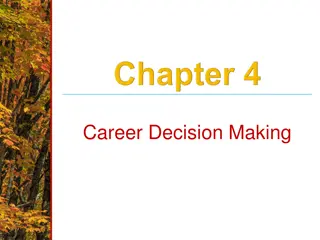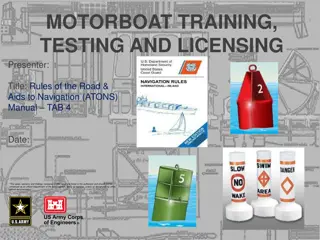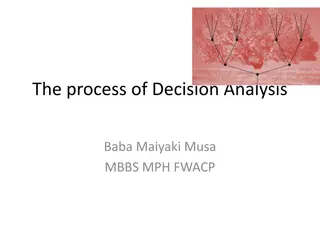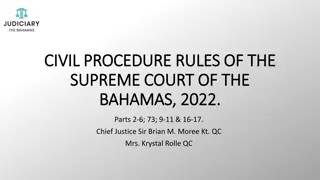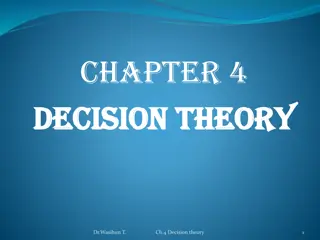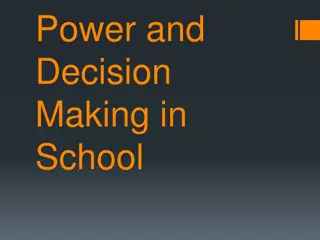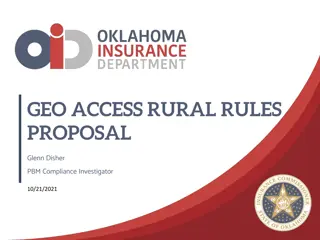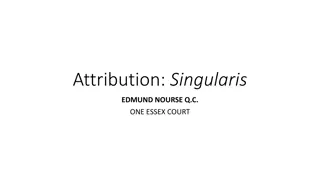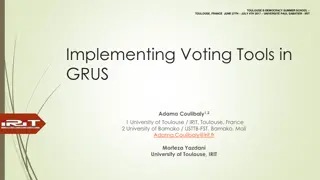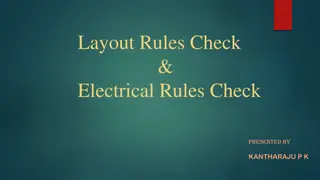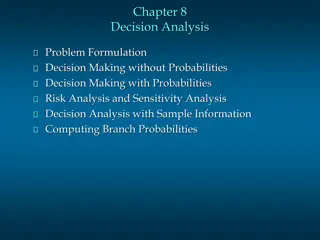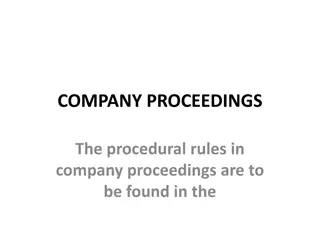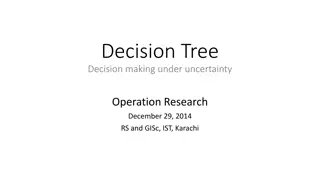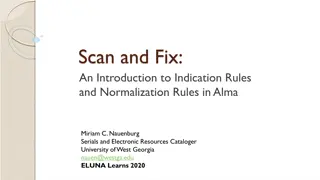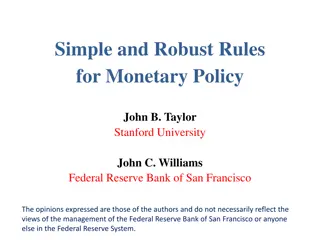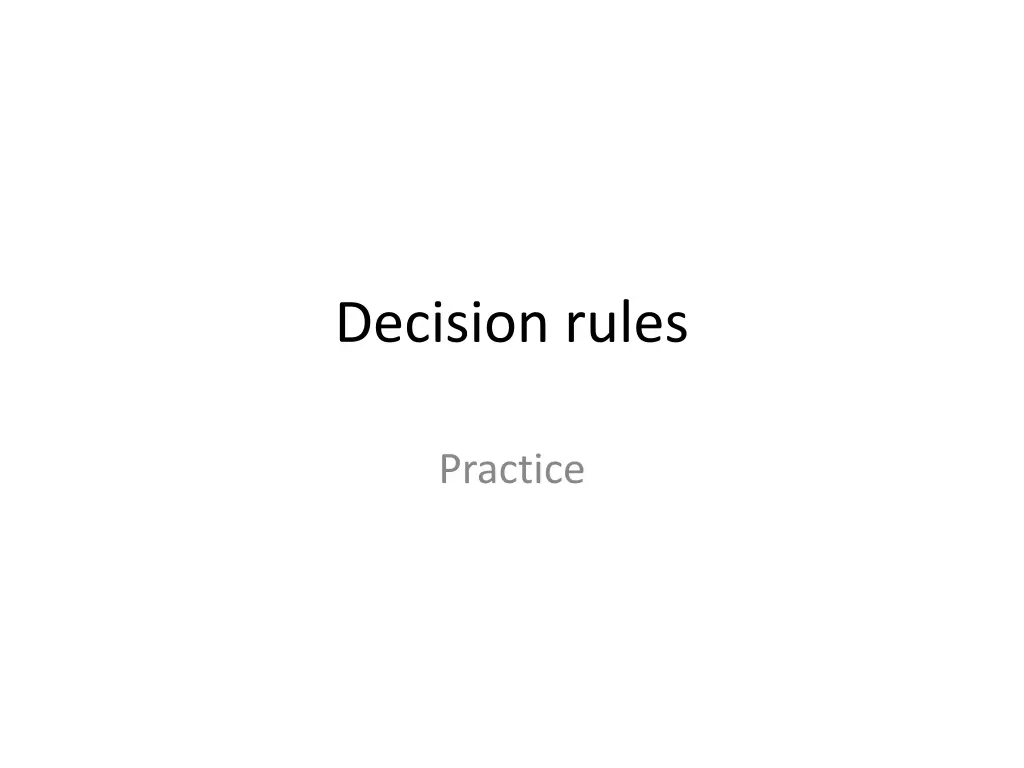
Decision Rules Practice with Decision Tree Approach
Learn about decision rules extracted directly from a decision tree using the PRISM algorithm. Understand how attribute-value pairs are used to split data, enhancing the classification process for predictive modeling.
Download Presentation

Please find below an Image/Link to download the presentation.
The content on the website is provided AS IS for your information and personal use only. It may not be sold, licensed, or shared on other websites without obtaining consent from the author. If you encounter any issues during the download, it is possible that the publisher has removed the file from their server.
You are allowed to download the files provided on this website for personal or commercial use, subject to the condition that they are used lawfully. All files are the property of their respective owners.
The content on the website is provided AS IS for your information and personal use only. It may not be sold, licensed, or shared on other websites without obtaining consent from the author.
E N D
Presentation Transcript
Decision rules Practice
Decision or classification rules "Read directly" from a decision tree The PRISM algorithm (covering approach) similar than "from decision tree" approach, but this time attribute-value is used to split the data instead of just the attribute
Outlook Temp Hum Windy Play Sunny Hot High False No Seeking the rules for class No . If ? then Play=no Outlook=sunny: Outlook=overcast: Outlook=rainy: Temp=cool: Temp=mild: Temp=hot: Hum=high: Hum=normal: Windy=true: Windy=false: Sunny Hot High True No Overcast Hot High False Yes 3/5 0/4 2/5 1/4 2/6 2/4 4/7 1/7 3/6 2/8 Rainy Mild High False Yes Rainy Cool Normal False Yes Rainy Cool Normal True No Overcast Cool Normal True Yes Sunny Mild High False No Sunny Cool Normal False Yes Rainy Mild Normal False Yes Sunny Mild Normal True Yes Overcast Mild High True Yes Overcast Hot Normal False Yes Rainy Mild High True No If Outlook=sunny and ? then Play=no Temp=hot: Temp=mild: Temp=cool: Hum=high: Hum=normal: Windy=false: Windy=true: 2/2 1/2 0/1 3/3 2/2 2/3 1/2 Outlook Temp Hum Windy Play Sunny Hot High False No Sunny Hot High True No Sunny Mild High False No Sunny Cool Normal False Yes Sunny Mild Normal True Yes If Outlook=sunny and Hum=high then Play=no
Outlook Temp Hum Windy Play Sunny Hot High False No If Outlook=sunny and Hum=high then Play=no If ? then Play=no Outlook=sunny: Outlook=overcast: Outlook=rainy: Temp=cool: Temp=mild: Temp=hot: Hum=high: Hum=normal: Windy=true: Windy=false: Sunny Hot High True No Overcast Hot High False Yes Rainy Mild High False Yes 0/2 0/4 2/5 1/4 1/5 0/2 1/4 1/7 2/5 0/6 Rainy Cool Normal False Yes Rainy Cool Normal True No Overcast Cool Normal True Yes Sunny Mild High False No Sunny Cool Normal False Yes Rainy Mild Normal False Yes Sunny Mild Normal True Yes Overcast Mild High True Yes Overcast Hot Normal False Yes Rainy Mild High True No If Outlook=rainy and ? then Play=no Temp=mild: Temp=cool: Hum=high: Hum=normal: Windy=false: Windy=true: 1/3 1/2 1/2 1/3 0/3 2/2 Outlook Temp Hum Windy Play Rainy Mild High False Yes Rainy Cool Normal False Yes Rainy Cool Normal True No Rainy Mild Normal False Yes Rainy Mild High True No If Outlook=rainy and Windy=true then Play=no
RULES FOR CLASS No: If Outlook=sunny and Hum=high then Play=no If Outlook=rainy and Windy=true then Play=no
Outlook Temp Hum Windy Play Sunny Hot High False No Seeking the rules for class Yes . If ? then Play=yes Outlook=sunny: Outlook=overcast: Outlook=rainy: Temp=cool: Temp=mild: Temp=hot: Hum=high: Hum=normal: Windy=true: Windy=false: Sunny Hot High True No Overcast Hot High False Yes 2/5 4/4 3/5 3/4 4/6 2/4 3/7 6/7 3/6 6/8 Rainy Mild High False Yes Rainy Cool Normal False Yes Rainy Cool Normal True No Overcast Cool Normal True Yes Sunny Mild High False No Sunny Cool Normal False Yes Rainy Mild Normal False Yes Sunny Mild Normal True Yes Overcast Mild High True Yes Overcast Hot Normal False Yes Rainy Mild High True No If Outlook=overcast then Play=yes
Outlook Temp Hum Windy Play If Outlook=overcast then Play=yes Sunny Hot High False No Sunny Hot High True No Seeking rules for remaining examples. If ? then Play=yes Outlook=sunny: Outlook=rainy: Temp=hot: Temp=mild: Temp=cool: Hum=high: Hum=normal: Windy=true: Windy=false: Overcast Hot High False Yes Rainy Mild High False Yes 2/5 3/5 0/2 3/5 2/3 1/5 4/5 1/4 4/6 Rainy Cool Normal False Yes Rainy Cool Normal True No Overcast Cool Normal True Yes Sunny Mild High False No Sunny Cool Normal False Yes Rainy Mild Normal False Yes Sunny Mild Normal True Yes Overcast Mild High True Yes Overcast Hot Normal False Yes Rainy Mild High True No If Hum=Normal and ? then Play=yes Outlook=rainy: Outlook=sunny: Temp=cool: Temp=mild: Windy=false: Windy=true: Outlook Temp Hum Windy Play 2/3 2/2 2/3 2/2 3/3 1/2 Rainy Cool Normal False Yes Rainy Cool Normal True No Sunny Cool Normal False Yes Rainy Mild Normal False Yes Sunny Mild Normal True Yes If Hum=Normal and Windy=false then Play=yes
Outlook Temp Hum Windy Play If Outlook=overcast then Play=yes If Hum=Normal and Windy=false then Play=yes Sunny Hot High False No Sunny Hot High True No Overcast Hot High False Yes If ? then Play=yes Outlook=rainy: Outlook=sunny: Temp=hot: Temp=mild: Temp=cool: Hum=high: Hum=normal: Windy=false Windy=true: Rainy Mild High False Yes 1/3 1/4 0/2 2/4 0/1 1/5 1/2 1/3 1/4 Rainy Cool Normal False Yes Rainy Cool Normal True No Overcast Cool Normal True Yes Sunny Mild High False No Sunny Cool Normal False Yes Rainy Mild Normal False Yes Sunny Mild Normal True Yes Overcast Mild High True Yes Overcast Hot Normal False Yes Rainy Mild High True No If Temp=mild and ? then Play=yes Outlook=rainy: Outlook=sunny: Hum=high: Hum=normal: Windy=false: Windy=true: 1/2 1/2 1/3 1/1 1/2 1/2 Outlook Temp Hum Windy Play Rainy Mild High False Yes Sunny Mild High False No Sunny Mild Normal True Yes Rainy Mild High True No If Temp=mild and Hum=normal then Play=yes
Outlook Temp Hum Windy Play If Outlook=overcast then Play=yes If Hum=Normal and Windy=false then Play=yes If Temp=mild and Hum=normal then Play=yes Sunny Hot High False No Sunny Hot High True No Overcast Hot High False Yes Rainy Mild High False Yes If ? then Play=yes Outlook=rainy: Outlook=sunny: Temp=hot: Temp=mild: Temp=cool: Hum=high: Hum=normal: Windy=false Windy=true: Rainy Cool Normal False Yes 1/3 0/3 0/2 1/3 0/1 1/5 0/2 1/3 0/3 Rainy Cool Normal True No Overcast Cool Normal True Yes Sunny Mild High False No Sunny Cool Normal False Yes Rainy Mild Normal False Yes Sunny Mild Normal True Yes Overcast Mild High True Yes Overcast Hot Normal False Yes Rainy Mild High True No If Outlook=rainy and ? then Play=yes Temp=mild: Temp=cool: Hum=high: Hum=normal: Windy=false: Windy=true: 1/2 0/1 1/2 0/1 1/1 0/2 Outlook Temp Hum Windy Play Rainy Mild High False Yes Rainy Cool Normal True No Rainy Mild High True No If Outlook=rainy and Windy=false then Play=yes
RULES FOR CLASS Yes: If Outlook=overcast then Play=yes If Hum=normal and Windy=false then Play=yes If Temp=mild and Hum=normal then Play = yes If Outlook=rainy and Windy=false then Play = yes The order is not important, because all rules cover the same class !!!
A comparison with the decision tree RULES FOR CLASS Yes : RULES FOR CLASS No : If Outlook=overcast then Play=yes If Outlook=sunny and Hum=high then Play=no If Hum=normal and Windy=false then Play=yes If Outlook=rainy and Windy=true then Play=no If Temp=mild and Hum=normal then Play=yes If Outlook=rainy and Windy=false then Play=yes
Lets try another example on the "contact lenses" data (contact-lenses.arff)


